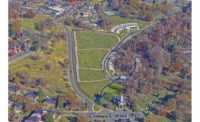Flight 93 National Memorial Plaza and Visitor Center
Stonycreek Township, Pa.
Best Project
Owner National Park Service, U.S. Dept. of the Interior
Lead Design Firm Paul Murdoch Architects
General Contractor URS Group Inc. (An AECOM Company)
Civil Engineer H.F. Lenz Co.
Structural Engineer Silman
MEP Engineer H.F. Lenz Co.
Landscape Architect Nelson Byrd Woltz
Acoustical Shaffer Acoustics Inc.
Lighting Designer George Sexton Associates
Sustainability Zinner Consultants
Commissioning Onix Inc.
Geotechnical Garvin Boward Beitko Engineering Inc.
The Flight 93 National Memorial near Shanksville, Pa., which opened 14 years after passengers and crew thwarted a terrorist attack on the U.S. Capitol on Sept. 11, 2001, features a black granite walkway that traces the flight path.
Two large memorial walls are constructed at angles similar to the branches of hemlock trees where the crash occurred. The 20-in.-thick cast-in-place concrete walls shaped like airplane wings range in height from 18 ft to 50 ft. As people walk through the narrow opening between the walls, they see the crash site. A large boulder marks the spot where the aircraft’s nose hit the ground. The LEED Gold-certified visitor center is located on a ridge overlooking the crash site, near a memorial wall that lists victims’ names.
The project team noted in its submission that the visitor center and memorial “offer a timeless tranquility appropriate for the final resting place of 40 heroes, combined with the starkness of an open, windswept landscape where one of the most courageous acts in American history occurred.”
The $25.3-million project involved rough-grading more than 100,000 cu yd of cut-and-fill operations, excavation for footings, pile foundations and MEP utilities. Sitework also included sediment and erosion control for the area, which had once been a coal mine. Landscaping included a variety of turf, trees and native wildflowers along with subdued lighting for way-finding and viewing the memorial at night.
Construction of the 2,200-acre national memorial located in the Alleghany Mountains was complicated by heavy rains, early snows and high winds. Extreme weather made work on a pedestrian bridge through wetlands especially difficult. While the initial design required “aqua dams” to dewater the areas where the piers would be constructed, the project team realized that approach would not withstand heavy rains and snow runoff during foundation work. A more economical and conventional dewatering strategy was adopted. Water was pumped into existing pipes beneath the road through an additional rock filter to reduce silt and maintain the integrity of the wetlands.
Frigid temperatures—as low as minus 11 degrees Fahrenheit—also threatened the project schedule. AECOM worked with subcontractors and material providers to develop strategies that avoided delays. For example, the learning center was covered in plastic sheeting so the team could work in the rain. Ultimately, the project finished seven days early, giving the client extra time to prepare for a dedication ceremony held on the 14th anniversary of the 9/11 attacks.







Post a comment to this article
Report Abusive Comment